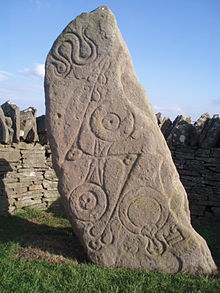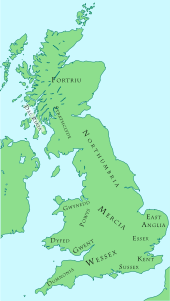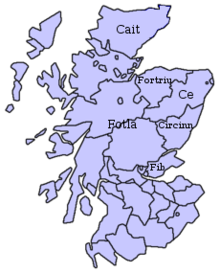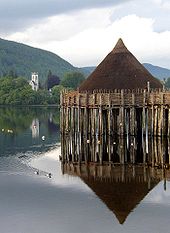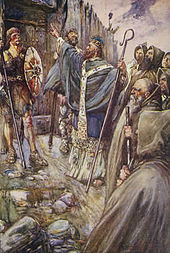- Picts
-
This article is about the Celtic tribes. For the graphic file format, see PICT.
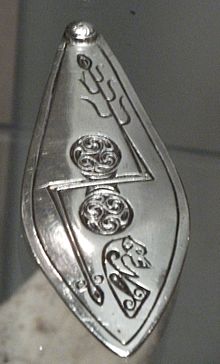 Silver plaque from Norrie's Law, Fife, with Z-rod
Silver plaque from Norrie's Law, Fife, with Z-rod
The Picts were a group of Late Iron Age and Early Mediaeval people living in what is now eastern and northern Scotland.[1] There is an association with the distribution of brochs, place names beginning 'Pit-', for instance Pitlochry, and Pictish stones. They are recorded from before the Roman conquest of Britain until the 10th century, when they merged with the Gaels. They lived to the north of the rivers Forth and Clyde, and spoke the extinct Pictish language, thought to have been related to the Brythonic languages spoken by the Britons to the south. They are assumed to have been the descendants of the Caledonii and other tribes named by Roman historians or found on the world map of Ptolemy. Pictland, also known as Pictavia, gradually merged with the Gaelic kingdom of Dál Riata to form the Kingdom of Alba (Scotland). Alba expanded, absorbing the Brythonic kingdom of Strathclyde and Bernician Lothian, and by the 11th century the Pictish identity had been subsumed into the "Scots" amalgamation of peoples.
Pictish society was typical of many Iron Age societies in northern Europe, having "wide connections and parallels" with neighbouring groups.[2]
Archaeology gives some impression of the society of the Picts. While very little in the way of Pictish writing has survived, Pictish history since the late 6th century is known from a variety of sources, including Bede's Historia ecclesiastica gentis Anglorum, saints' lives such as that of Columba by Adomnán, and various Irish annals. Although the popular impression of the Picts may be one of an obscure, mysterious people, this is far from being the case. When compared with the generality of Northern, Central and Eastern Europe in Late Antiquity and the Early Middle Ages, Pictish history and society are well attested.[3]
Contents
Names
The name the Picts called themselves is unknown.[4] The Latin word Picti first occurs in a panegyric written by Eumenius in AD 297 and is taken to mean "painted or tattooed people" (from Latin pingere "to paint",;[5] pictus, "painted", cf. Greek "πυκτίς" - puktis, "picture").[6] As Sally M. Foster noted, "Much ink has been spilt over what the ancient writers meant by Picts, but it seems to be a generic term for people living north of the Forth-Clyde isthmus who raided the Roman Empire."[7]
Their Old English name[8] gave the modern Scots form Pechts and the Welsh word Fichti.[citation needed] In writings from Ireland, the name Cruthin, Cruthini, Cruthni, Cruithni or Cruithini (Modern Irish: Cruithne) was used to refer to the Picts and to a group of people who lived alongside the Ulaid in eastern Ulster.[9] It is generally accepted that this is derived from *Qritani, which is the Goidelic/Q-Celtic version of the Britonnic/P-Celtic *Pritani.[10] From this came Britanni, the Roman name for those now called the Britons.[9][10][11] It has been suggested that Cruthin was a name used to refer to all the Britons who were not conquered by the Romans; those who lived outside Roman Britannia, north of Hadrian's Wall.[11]
History
The means by which the Pictish confederation formed in Late Antiquity from a number of tribes is unknown, although there is speculation that reaction to the growth of the Roman Empire was a factor.[12]
Pictland had previously been described as the home of the Caledonii.[13] Other tribes said to have lived in the area included the Verturiones, Taexali and Venicones.[14] Except for the Caledonians, the names may be second- or third-hand: perhaps as reported to the Romans by speakers of Brythonic or Gaulish languages.[15]
Pictish recorded history begins in the Dark Ages. It appears that they were not the dominant power in Northern Britain for the entire period. The Gaels of Dál Riata controlled their own region for a time, but suffered a series of defeats in the first third of the 7th century.[16] The Angles of Bernicia overwhelmed the adjacent British kingdoms, and the neighbouring Anglian kingdom of Deira (Bernicia and Deira later being called Northumbria) was to become the most powerful kingdom in Britain.[17] The Picts were probably tributary to Northumbria until the reign of Bridei map Beli, when the Anglians suffered a defeat at the Battle of Dun Nechtain that halted their northward expansion. The Northumbrians continued to dominate southern Scotland for the remainder of the Pictish period.
In the reign of Óengus mac Fergusa (729–761), Dál Riata was very much subject to the Pictish king. Although it had its own kings from the 760s, it appears that Dál Riata did not recover.[18] A later Pictish king, Caustantín mac Fergusa (793–820), placed his son Domnall on the throne of Dál Riata (811–835).[19] Pictish attempts to achieve a similar dominance over the Britons of Alt Clut (Dumbarton) were not successful.[20]
The Viking Age brought great changes in Britain and Ireland, no less in Scotland than elsewhere. The kingdom of Dál Riata was destroyed, certainly by the middle of the 9th century, when Ketil Flatnose is said to have founded the Kingdom of the Isles. Northumbria too succumbed to the Vikings, who founded the Kingdom of York, and the Kingdom of Strathclyde was also greatly affected. The king of Fortriu Eógan mac Óengusa, the king of Dál Riata Áed mac Boanta, and many more, were killed in a major battle against the Vikings in 839.[21] The rise of Cínaed mac Ailpín (Kenneth MacAlpin) in the 840s, in the aftermath of this disaster, brought to power the family who would preside over the last days of the Pictish kingdom and found the new kingdom of Alba, although Cínaed himself was never other than king of the Picts.[citation needed]
In the reign of Cínaed's grandson, Caustantín mac Áeda (900–943), the kingdom of the Picts became the kingdom of Alba. The change from Pictland to Alba may not have been noticeable at first; indeed, as we do not know the Pictish name for their land, it may not have been a change at all. The Picts, along with their language, did not disappear suddenly. The process of Gaelicisation, which may have begun generations earlier, continued under Caustantín and his successors. When the last inhabitants of Alba became fully Gaelicised Scots, probably during the 11th century, the Picts were soon forgotten.[22] Later they would reappear in myth and legend.[23]
Kings and kingdoms
See also: List of Kings of the PictsThe early history of Pictland is unclear. In later periods multiple kings existed, ruling over separate kingdoms, with one king, sometimes two, more or less dominating their lesser neighbours.[24] De Situ Albanie, a late document, the Pictish Chronicle, the Duan Albanach, along with Irish legends, have been used to argue the existence of seven Pictish kingdoms. These are as follows; those in bold are known to have had kings, or are otherwise attested in the Pictish period:
- Cait, situated in modern Caithness and Sutherland
- Ce, situated in modern Mar and Buchan
- Circinn, perhaps situated in modern Angus and the Mearns[25]
- Fib, the modern Fife, known to this day as 'the Kingdom of Fife'
- Fidach, location unknown
- Fotla, modern Atholl (Ath-Fotla)[26]
- Fortriu, cognate with the Verturiones of the Romans; recently shown to be centered around Moray[27]
 Map showing the approximate areas of the kingdom of Fortriu and neighbours c. 800, and the kingdom of Alba c. 900
Map showing the approximate areas of the kingdom of Fortriu and neighbours c. 800, and the kingdom of Alba c. 900
More small kingdoms may have existed. Some evidence suggests that a Pictish kingdom also existed in Orkney.[28] De Situ Albanie is not the most reliable of sources, and the number of kingdoms, one for each of the seven sons of Cruithne, the eponymous founder of the Picts, may well be grounds enough for disbelief.[29] Regardless of the exact number of kingdoms and their names, the Pictish nation was not a united one.
For most of Pictish recorded history the kingdom of Fortriu appears dominant, so much so that king of Fortriu and king of the Picts may mean one and the same thing in the annals. This was previously thought to lie in the area around Perth and the southern Strathearn, whereas recent work has convinced those working in the field that Moray (a name referring to a very much larger area in the High Middle Ages than the county of Moray), was the core of Fortriu.[30]
The Picts are often said to have practised matrilineal succession on the basis of Irish legends and a statement in Bede's history. In fact, Bede merely says that the Picts used matrilineal succession in exceptional cases.[31] The kings of the Picts when Bede was writing were Bridei and Nechtan, sons of Der Ilei, who indeed claimed the throne through their mother Der Ilei, daughter of an earlier Pictish king.[32]
In Ireland, kings were expected to come from among those who had a great-grandfather who had been king.[33] Kingly fathers were not frequently succeeded by their sons, not because the Picts practised matrilineal succession, but because they were usually followed by their own brothers or cousins, more likely to be experienced men with the authority and the support necessary to be king.[34]
The nature of kingship changed considerably during the centuries of Pictish history. While kings had to be successful war leaders to maintain their authority, kingship became rather less personalised and more institutionalised during this time. Bureaucratic kingship was still far in the future when Pictland became Alba, but the support of the church, and the apparent ability of a small number of families to control the kingship for much of the period from the later 7th century onwards, provided a considerable degree of continuity. In much the same period, the Picts' neighbours in Dál Riata and Northumbria faced considerable difficulties, as the stability of succession and rule that previously benefited them ended.[35]
The later Mormaers are thought to have originated in Pictish times, and to have been copied from, or inspired by, Northumbrian usages.[36] It is unclear whether the Mormaers were originally former kings, royal officials, or local nobles, or some combination of these. Likewise, the Pictish shires and thanages, traces of which are found in later times, are thought to have been adopted from their southern neighbours.[37]
Society
 The harpist on the Dupplin Cross, Scotland, c. 800 AD
The harpist on the Dupplin Cross, Scotland, c. 800 AD
The archaeological record provides evidence of the material culture of the Picts. It tells of a society not readily distinguishable from its similar Gaelic and British neighbours, nor very different from the Anglo-Saxons to the south.[38] Although analogy and knowledge of other Celtic societies may be a useful guide, these extended across a very large area. Relying on knowledge of pre-Roman Gaul, or 13th century Ireland, as a guide to the Picts of the 6th century may be misleading if analogy is pursued too far.
As with most peoples in the north of Europe in Late Antiquity, the Picts were farmers living in small communities. Cattle and horses were an obvious sign of wealth and prestige, sheep and pigs were kept in large numbers, and place names suggest that transhumance was common. Animals were small by later standards, although horses from Britain were imported into Ireland as breed-stock to enlarge native horses. From Irish sources it appears that the élite engaged in competitive cattle-breeding for size, and this may have been the case in Pictland also. Carvings show hunting with dogs, and also, unlike in Ireland, with falcons. Cereal crops included wheat, barley, oats and rye. Vegetables included kale, cabbage, onions and leeks, peas and beans, turnips and carrots, and some types no longer common, such as skirret. Plants such as wild garlic, nettles and watercress may have been gathered in the wild. The pastoral economy meant that hides and leather were readily available. Wool was the main source of fibres for clothing, and flax was also common, although it is not clear if they grew it for fibres, for oil, or as a foodstuff. Fish, shellfish, seals, and whales were exploited along coasts and rivers. The importance of domesticated animals argues that meat and milk products were a major part of the diet of ordinary people, while the élite would have eaten a diet rich in meat from farming and hunting.[39]
No Pictish counterparts to the areas of denser settlement around important fortresses in Gaul and southern Britain, or any other significant urban settlements, are known. Larger, but not large, settlements existed around royal forts, such as at Burghead, or associated with religious foundations.[40] No towns are known in Scotland until the 12th century.[41]
The technology of everyday life is not well recorded, but archaeological evidence shows it to have been similar to that in Ireland and Anglo-Saxon England. Recently evidence has been found of watermills in Pictland.[42] Kilns were used for drying kernels of wheat or barley, not otherwise easy in the changeable, temperate climate.[43]
The early Picts are associated with piracy and raiding along the coasts of Roman Britain. Even in the Late Middle Ages, the line between traders and pirates was unclear, so that Pictish pirates were probably merchants on other occasions. It is generally assumed that trade collapsed with the Roman Empire, but this is to overstate the case. There is only limited evidence of long-distance trade with Pictland, but tableware and storage vessels from Gaul, probably transported up the Irish Sea, have been found. This trade may have been controlled from Dunadd in Dál Riata, where such goods appear to have been common. While long-distance travel was unusual in Pictish times, it was far from unknown as stories of missionaries, travelling clerics and exiles show.[44]
Brochs are popularly associated with the Picts. Although these were built earlier in the Iron Age, with construction ending around 100 AD, they remained in use into and beyond the Pictish period.[45] Crannóg, which may originate in Neolithic Scotland, may have been rebuilt, and some were still in use in the time of the Picts.[46] The most common sort of buildings would have been roundhouses and rectangular timbered halls.[47] While many churches were built in wood, from the early 8th century, if not earlier, some were built in stone.[48]
The Picts are often said to have tattooed themselves, but evidence for this is limited. Naturalistic depictions of Pictish nobles, hunters and warriors, male and female, without obvious tattoos, are found on monumental stones. These stones include inscriptions in Latin and ogham script, not all of which have been deciphered. The well known Pictish symbols found on stones, and elsewhere, are obscure in meaning. A variety of esoteric explanations have been offered, but the simplest conclusion may be that these symbols represent the names of those who had raised, or are commemorated on, the stones. Pictish art can be classed as Celtic, and later as Insular.[49] Irish poets portrayed their Pictish counterparts as very much like themselves.[50]
Religion
Early Pictish religion is presumed to have resembled Celtic polytheism in general, although only place names remain from the pre-Christian era. When the Pictish elite converted to Christianity is uncertain, but traditions place Saint Palladius in Pictland after he left Ireland, and link Abernethy with Saint Brigid of Kildare.[51] Saint Patrick refers to "apostate Picts", while the poem Y Gododdin does not remark on the Picts as pagans.[52] Bede wrote that Saint Ninian (confused by some with Saint Finnian of Moville, who died c. 589), had converted the southern Picts.[53] Recent archaeological work at Portmahomack places the foundation of the monastery there, an area once assumed to be among the last converted, in the late 6th century.[54] This is contemporary with Bridei mac Maelchon and Columba, but the process of establishing Christianity throughout Pictland will have extended over a much longer period.
Pictland was not solely influenced by Iona and Ireland. It also had ties to churches in Northumbria, as seen in the reign of Nechtan mac Der Ilei. The reported expulsion of Ionan monks and clergy by Nechtan in 717 may have been related to the controversy over the dating of Easter, and the manner of tonsure, where Nechtan appears to have supported the Roman usages, but may equally have been intended to increase royal power over the church.[55] Nonetheless, the evidence of place names suggests a wide area of Ionan influence in Pictland.[56] Likewise, the Cáin Adomnáin (Law of Adomnán, Lex Innocentium) counts Nechtan's brother Bridei among its guarantors.
The importance of monastic centres in Pictland was not, perhaps, as great as in Ireland. In areas that have been studied, such as Strathspey and Perthshire, it appears that the parochial structure of the High Middle Ages existed in early medieval times. Among the major religious sites of eastern Pictland were Portmahomack, Cennrígmonaid (later St Andrews), Dunkeld, Abernethy and Rosemarkie. It appears that these are associated with Pictish kings, which argues for a considerable degree of royal patronage and control of the church.[57] Portmahomack in particular has been the subject of recent excavation and research, published by Martin Carver.[58]
The cult of Saints was, as throughout Christian lands, of great importance in later Pictland. While kings might patronise great Saints, such as Saint Peter in the case of Nechtan, and perhaps Saint Andrew in the case of the second Óengus mac Fergusa, many lesser Saints, some now obscure, were important. The Pictish Saint Drostan appears to have had a wide following in the north in earlier times, although all but forgotten by the 12th century. Saint Serf of Culross was associated with Nechtan's brother Bridei.[59] It appears, as is well known in later times, that noble kin groups had their own patron saints, and their own churches or abbeys.[60]
Art
 The Rogart brooch, National Museums of Scotland, FC2. Pictish penannular brooch, 8th century, silver with gilding and glass. Classified as Fowler H3 type.[61]
The Rogart brooch, National Museums of Scotland, FC2. Pictish penannular brooch, 8th century, silver with gilding and glass. Classified as Fowler H3 type.[61]
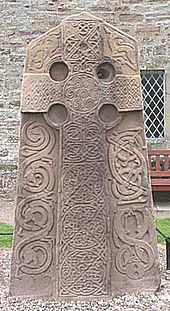 The Aberlemno Kirkyard Stone, Class II Pictish stone
The Aberlemno Kirkyard Stone, Class II Pictish stone
Pictish art appears on stones, metalwork and small objects of stone and bone. It uses a distinctive form of the general Celtic Early Medieval development of La Tène style with increasing influences from the Insular art of 7th and 8th century Ireland and Northumbria, and then Anglo-Saxon and Irish art as the Early Medieval period continues. The most conspicuous survivals are the many Pictish stones that are located all over Pictland, from Inverness to Lanarkshire. An illustrated catalogue of these stones was produced by J. Romilly Allen as part of The Early Church Monuments of Scotland, with lists of their symbols and patterns. The symbols and patterns consist of animals including the Pictish Beast, the "rectangle", the "mirror and comb", "double-disk and Z-rod" and the "crescent and V-rod," among many others. There are also bosses and lenses with pelta and spiral designs. The patterns are curvilinear with hatchings. The so-called cross-slabs are carved with Pictish symbols, Insular-derived interlace and Christian imagery, though interpretation is often difficult due to wear and obscurity. Several of the Christian images carved on various stones, such as David the harpist, David and the lion, or scenes of St Paul and St Anthony meeting in the desert, have been influenced by the Insular manuscript tradition.[62]
Pictish metalwork is found throughout Pictland and also further south; the Picts appear to have a considerable amount of silver available, probably from raiding further south, or the payment of subsidies to keep them from doing so. The very large hoard of late Roman hacksilver found at Traprain Law may have originated in either way. The largest hoard of early Pictish metalwork was found in 1819 at Norrie's Law in Fife, but unfortunately much was dispersed and melted down (Scottish law on treasure finds has always been unhelpful to preservation). Two famous 7th century silver and enamel plaques from the hoard, one shown above, have a "Z-rod", one of the Pictish symbols, in a particularly well-preserved and elegant form; unfortunately few comparable pieces have survived.[63] Over ten heavy silver chains, some over 0.5m long, have been found from this period; the double-linked Whitecleuch Chain is one of only two that have a penannular ring, with symbol decoration including enamel, which shows how these were probably used as "choker" necklaces.[64]
In the 8th and 9th centuries, after Christianization, the Pictish elite adopted a particular form of the Celtic brooch from Ireland, preferring true penannular brooches with lobed terminals. Some older Irish pseudo-penannular brooches were adapted to the Pictish style, for example the Breadalbane Brooch (British Museum). The St Ninian's Isle Treasure contains the best collection of Pictish forms. Other characteristics of Pictish metalwork are dotted backgrounds or designs and animal forms influenced by Insular art. The 8th century Monymusk Reliquary has elements of Pictish and Irish style.[65]
Language
Main article: Pictish languageThe Pictish language has not survived. Evidence is limited to place names, the names of people found on monuments, and the contemporary records. The evidence of place-names and personal names argues strongly that the Picts spoke Insular Celtic languages related to the more southerly Brythonic languages.[66] A number of ogham inscriptions have been argued to be unidentifiable as Celtic, and on this basis, it has been suggested that non-Celtic languages were also in use.[67]
The absence of surviving written material in Pictish - if we discount the ambiguous "Pictish inscriptions" in the ogham script - does not indicate a pre-literate society. The church certainly required literacy in Latin, and could not function without copyists to produce liturgical documents. Pictish iconography shows books being read, and carried, and its naturalistic style gives every reason to suppose that such images were of real life. Literacy was not widespread, but among the senior clergy, and in monasteries, it would have been common enough.[68]
Place-names often allow us to deduce the existence of historic Pictish settlements in Scotland. Those prefixed with the Welsh prefixes "Aber-", "Lhan-", or "Pit-" (=? "peth", a thing) are claimed to indicate regions inhabited by Picts in the past (for example: Aberdeen, Lhanbryde, Pitmedden, etc.). Some of these, such as "Pit-" (portion, share), may have been formed after Pictish times, and may refer to previous "shires" or "thanages".[69]
The evidence of place-names may also reveal the advance of Gaelic into Pictland. As noted, Atholl, meaning New Ireland, is attested in the early 8th century. This may be an indication of the advance of Gaelic. Fortriu also contains place-names suggesting Gaelic settlement, or Gaelic influences.[70]
In literature and popular culture
Pulp fiction author Robert E. Howard wrote extensively about his romanticized version of the Picts, especially in his short stories revolving around the fictional character Bran Mak Morn, but also in many other of his stories.
Rudyard Kipling devotes several chapters to the Picts in his book Puck of Pook's Hill. Historical fantasy author Juliet Marillier's series The Bridei Chronicles tells of the Picts and Gaels in the sixth century A.D.[71] Nancy Farmer's series The Sea of Trolls depicts fictional Picts.[72] Anne Rice also wrote of fictional Picts, crafting them into the Taltos for her book series The Lives of the Mayfair Witches.
Yet another use of the Picts in a fantasy setting comes in Jacqueline Carey's Kushiel's Legacy fantasy series concerning the Kingdom of Alba and the Picts, and their dealings with Terre D'Ange.
Matthew Stover's Bronze Age fantasy novels Iron Dawn and Jericho Moon chronicle the adventures of Barra Coll Eigg Rhum, a Pictish princess.
The 1982 film Conan The Barbarian features bodybuilder Franco Columbu in a cameo as a blue-tattooed Pictish scout. The 2004 film King Arthur depicts the Picts (called "Woads" in the film) as tattooed and painted savage forest people, led by the dark magician Merlin. Originally enemies to Arthur and his knights, they later unite to defeat the Saxons at Badon Hill. Neil Marshall's 2010 film Centurion features a conflict between a band of Picts and the Roman Ninth Legion. Duncan Kenworthy's 2011 film The Eagle depicts the quest of a Roman officer, portrayed as the son of the commander of the Ninth Legion, into the country of the Picts to retrieve the Ninth's standard along with his Brigantian slave, whom he frees during their journey.
In Terry Pratchett's Discworld novels, particularly those featuring the Lancre witches, the Picts are an obvious influence on the Nac Mac Feegle, a race of tiny wood-fairies whose speech is influenced by Scottish Gaelic and who are tattooed with blue war-paint. In Carpe Jugulum, they are called "Pictsies."
On their 1969 album Ummagumma, Pink Floyd included a song called "Several Species of Small Furry Animals Gathered Together in a Cave and Grooving with a Pict", which consisted, as its name suggests, of various animal noises followed by supposedly "Pictish" speech.
In the 1st season episode of Bones, "The Woman at the Airport", the Jeffersonian team is called in to identify a Bronze Age skeleton that Dr Goodman identifies as a Pict.
See also
- Caledonians
- Duan Albanach
- Fortriu
- Kings of the Picts
References
- Footnotes
- ^ Foster 1996. p. 11-13.
- ^ Foster 1996. p. 17.
- ^ Sources for Pictish history include Irish Annals - the Annals of Ulster, Tigernach, Innisfallen, Ireland (the Four Masters), and Clonmacnoise all report events in Scotland, some frequently; the Lebor Bretnach, Scottish recension of the Historia Britonum of Nennius; the continuation of Bede; the Historia Regum of Symeon of Durham; the Annales Cambriae; saints' lives; and others.
- ^ It has been proposed that albidosi, found in the Chronicle of the Kings of Alba under the reign of Máel Coluim mac Domnaill, may represent the Pictish name for Picts, but this is disputed: Broun, "Alba", p. 258, note 95; Woolf, Pictland to Alba, pp. 177–181.
- ^ pingo, Charlton T. Lewis, Charles Short, A Latin Dictionary, on Perseus Digital Library
- ^ πυκτίς, Henry George Liddell, Robert Scott, A Greek-English Lexicon, on Perseus Digital Library
- ^ Foster 1996. p. 11.
- ^ The Anglo-Saxon Chronicle has pihtas and pehtas.
- ^ a b Ó Cróinín, Dáibhí. A New History of Ireland: Prehistoric and Early Ireland. Oxford University Press, 2008. Page 213.
- ^ a b Chadwick, Hector Munro. Early Scotland: the Picts, the Scots & the Welsh of southern Scotland. CUP Archive, 1949. Page 66-80.
- ^ a b Dunbavin, Paul. Picts and ancient Britons: an exploration of Pictish origins. Third Millennium Publishing, 1998. Page 3.
- ^ See the discussion of the creation of the Frankish Confederacy in Geary, Before France, chapter 2.
- ^ e.g. by Tacitus, Ptolemy, and as the Dicalydonii by Ammianus Marcellinus. Note that Ptolemy refers to the sea to the west of Scotland as the Oceanus Duecaledonius.
- ^ e.g. Ptolemy, Ammianus Marcellinus.
- ^ Caledonii is attested from a grave marker in Roman Britain.
- ^ At Degsastan in the first decade of the century and several times under Domnall Brecc in the third and fourth decades.
- ^ For the kingdoms of Bernicia, and Northumbria, see e.g. Higham, The Kingdom of Northumbria.
- ^ Broun, "Pictish Kings", attempts to reconstruct the confused late history of Dál Riata. The silence in the Irish Annals is ignored by Bannerman in "The Scottish Takeover of Pictland and the relics of Columba".
- ^ After Broun, "Pictish Kings", but the later history of Dál Riata is very obscure.
- ^ Cf. the failed attempts by Óengus mac Fergusa.
- ^ Annals of Ulster (s.a. 839): "The (Vikings) won a battle against the men of Fortriu, and Eóganán son of Aengus, Bran son of Óengus, Aed son of Boanta, and others almost innumerable fell there."
- ^ Broun, "Dunkeld", Broun, "National Identity", Forsyth, "Scotland to 1100", pp. 28–32, Woolf, "Constantine II"; cf. Bannerman, "Scottish Takeover", passim, representing the "traditional" view.
- ^ For example, Pechs, and perhaps Pixies. However, Sally Foster quotes John Toland in 1726: "they are apt all over Scotland to make everything Pictish whose origin they do not know." The same could be said of the Picts in myth.
- ^ Broun, "Kingship", for Ireland see, e.g. Byrne, Irish Kings and High-Kings, and more generally Ó Cróinín, Early Medieval Ireland.
- ^ Forsyth, "Lost Pictish Source", Watson, Celtic Place Names, pp. 108–109.
- ^ Bruford, "What happened to the Caledonians", Watson, Celtic Place Names, pp. 108–113.
- ^ Woolf, "Dun Nechtain"; Yorke, Conversion, p. 47. Compare earlier works such as Foster, Picts, Gaels and Scots, p. 33.
- ^ Adomnán, "Life of Columba", editor's notes on pp. 342–343.
- ^ Broun, "Seven Kingdoms".
- ^ Woolf, "Dun Nechtain".
- ^ Bede, I, c. 1
- ^ Clancy, "Nechtan".
- ^ Byrne, Irish Kings and High-Kings, pp. 35–41 & pp. 122–123, also p. 108 & p. 287, stating that derbfhine was practised by the cruithni in Ireland.
- ^ Byrne, Irish Kings and High-Kings, p. 35, "Elder for kin, worth for rulership, wisdom for the church." See also Foster, Picts, Gaels and Scots, pp. 32–34, Smyth, Warlords and Holy Men, p. 67ff.
- ^ Broun, "Kingship", Broun, "Pictish Kings"; for Dál Riata, Broun, "Dál Riata", for a more positive view Sharpe, "The thriving of Dalriada"; for Northumbria, Higham, Kingdom of Northumbria, pp. 144–149.
- ^ Woolf, "Nobility".
- ^ Barrow, "Pre-Feudal Scotland", Woolf, "Nobility".
- ^ See, e.g. Campbell, Saints and Sea-kings for the Gaels of Dál Riata, Lowe, Angels, Fools and Tyrants for Britons and Anglians.
- ^ Foster, Picts, Gaels and Scots, pp. 49–61. Fergus Kelly, Early Irish Farming: a study based mainly on the law-texts of the 7th and 8th centuries AD (School of Celtic Studies/DAIS, Dublin, 2000. ISBN 1-85500-180-2) provides an extensive review of farming in Ireland in the middle Pictish period.
- ^ The interior of the fort at Burghead was some 12 acres (5 hectares) in size, see Driscoll, "Burghead"; for Verlamion (later Roman Verulamium), a southern British settlement on a very much larger scale, see e.g. Pryor, Britain AD, pp. 64–70.
- ^ Dennison, "Urban settlement: medieval".
- ^ Carver (2008)
- ^ Foster, Picts, Gaels and Scots, pp. 52–53.
- ^ Trade, see Foster, Picts, Gaels and Scots, pp. 65–68; seafaring in general, e.g. Haywood, Dark Age Naval Power, Rodger, Safeguard of the Sea.
- ^ Armit, Towers In The North, chapter 7.
- ^ Crone, "Crannogs and Chronologies", PSAS, vol. 123, pp. 245–254.
- ^ Foster, Picts, Gaels and Scots, pp. 52–61.
- ^ See Clancy, "Nechtan", Foster, Picts, Gaels and Scots, p. 89.
- ^ For art in general see Foster, Picts, Gaels and Scots, pp. 26–28, Laing & Laing, p. 89ff., Ritchie, "Picto-Celtic Culture".
- ^ Forsyth, "Evidence of a lost Pictish Source", pp. 27–28.
- ^ Clancy, "'Nennian recension'", pp. 95–96, Smyth, Warlords and Holy Men, pp. 82–83.
- ^ Markus, "Conversion to Christianity".
- ^ Bede, III, 4. For the identities of Ninian/Finnian see Yorke, p. 129.
- ^ Mentioned by Foster, but more information is available from the Tarbat Discovery Programme: see under External links.
- ^ Bede, IV, cc. 21–22, Clancy, "Church institutions", Clancy, "Nechtan".
- ^ Taylor, "Iona abbots".
- ^ Clancy, "Church institutions", Markus, "Religious life".
- ^ See Carver, Portmahomack.
- ^ Clancy, "Cult of Saints", Clancy, "Nechtan", Taylor, "Iona abbots"
- ^ Markus, "Religious life".
- ^ Youngs, no. 111, with a plate showing the decoration much better; Laing, 310
- ^ Henderson, Isabel,‘"The "David Cycle" in Pictish Art.' Early Medieval Sculpture. Ed. J.Higgitt. Oxford, 1986. pp. 87-113., ….. ‘The Meeting of Saint Paul and Saint Anthony: Visual and Literary Uses of a Eucharistic Motif.' Keimelia. Eds. P. Wallace and G.M Niocaill. Galway, 1989. pp 1-58.
- ^ Youngs, 26-28; Poor image of 19th century illustration
- ^ Youngs, 28
- ^ Youngs, 109-113
- ^ Forsyth, Language in Pictland, Price "Pictish", Taylor, "Place names", Watson, Celtic Place Names. For K.H. Jackson's views, see "The Language of the Picts" in Wainwright (ed.) The Problem of the Picts.
- ^ Jackson, "The Language of the Picts", discussed by Forsyth, Language in Pictland.
- ^ Forsyth, "Literacy in Pictland".
- ^ For place names in general, see Watson, Celtic Place Names; Nicolaisen, Scottish Place Names, pp 156–246. For shires and thanages see Barrow, "Pre-Feudal Scotland".
- ^ Watson, Celtic Place Names, pp. 225–233.
- ^ http://www.julietmarillier.com/books/brideihistoricalnotes.html
- ^ http://www.nancyfarmerwebsite.com/trolls-trilogy.html
- Bibliography
- Adomnán, Life of St Columba, tr. & ed. Richard Sharpe. Penguin, London, 1995. ISBN 0-14-044462-9
- Armit, Ian, Towers In The North: The Brochs Of Scotland Tempus, Stroud, 2002. ISBN 0-7524-1932-3
- Bannerman, John, "The Scottish Takeover of Pictland and the relics of Columba" in Dauvit Broun & Thomas Owen Clancy (eds.), Spes Scotorum: Hope of Scots. Saint Columba, Iona and the Scotland. T. & T. Clark, Edinburgh, 1999. ISBN 0-567-08682-8
- Barrow, G. W. S. "Pre-feudal Scotland: shires and thanes" in The Kingdom of the Scots. Edinburgh UP, Edinburgh, 2003. ISBN 0-7486-1803-1
- Broun, Dauvit (2005), "Alba: Pictish homeland or Irish offshoot?", in O'Neill, Pamela, Exile and Homecoming. Papers from the Fifth Australian Conference of Celtic Studies, University of Sydney, July 2004, Sydney Series in Celtic Studies, 8, Sydney: The Celtic Studies Foundation, University of Sydney, pp. 234–275, ISBN 1-86487-742-1
- Broun, Dauvit, "Dál Riata" in Lynch (2001).
- Broun, Dauvit, "Dunkeld and the origin of Scottish identity" in Broun & Clancy (1999).
- Broun, Dauvit, "National identity: early medieval and the formation of Alba" in Lynch (2001).
- Broun, Dauvit, "Pictish Kings 761–839: Integration with Dál Riata or Separate Development" in Sally M. Foster (ed.), The St Andrews Sarcophagus: A Pictish masterpiece and its international connections. Four Courts, Dublin, 1998. ISBN 1-85182-414-6
- Broun, Dauvit (2007), Scottish Independence and the Idea of Britain. From the Picts to Alexander III., Edinburgh: Edinburgh University Press, ISBN 978-0-7486-2360-0
- Broun, Dauvit, "The Seven Kingdoms in De situ Albanie: A Record of Pictish political geography or imaginary map of ancient Alba" in E.J. Cowan & R. Andrew McDonald (eds.), Alba: Celtic Scotland in the Medieval Era. John Donald, Edinburgh, 2005. ISBN 0-85976-608-X
- Bruford, Alan, "What happened to the Caledonians ?" in Cowan & McDonald (2005).
- Byrne, Francis John, Irish Kings and High-Kings. Batsford, London, 1973. ISBN 0-7134-5882-8
- Campbell, Ewan, Saints and Sea-kings: The First Kingdom of the Scots. Canongate, Edinburgh, 1999. ISBN 0-86241-874-7
- Carver, M.O.H. (2008), Portmahomack: monastery of the Picts, Edinburgh: Edinburgh University Press, ISBN 978-0-7486-2442-3, http://books.google.com/books?id=ajIcKFZwKGAC, retrieved February 6, 2010
- Clancy, Thomas Owen, "Church institutions: early medieval" in Lynch (2001).
- Clancy, Thomas Owen, "Ireland: to 1100" in Lynch (2001).
- Clancy, Thomas Owen, "Nechtan son of Derile" in Lynch (2001).
- Clancy, Thomas Owen, "Scotland, the 'Nennian' Recension of the Historia Brittonum and the Libor Bretnach in Simon Taylor (ed.), Kings, clerics and chronicles in Scotland 500–1297. Fourt Courts, Dublin, 2000. ISBN 1-85182-516-9
- Clancy, Thomas Owen, "Columba, Adomnán and the Cult of Saints in Scotland" in Broun & Clancy (1999).
- Cowan, E. J., "Economy: to 1100" in Lynch (2001).
- Cowan, E. J., "The Invention of Celtic Scotland" in Cowan & McDonald (2005).
- Crone, B. A., "Crannogs and Chronologies", PSAS, vol. 123 (1993), pp. 245–254.
- Cummins, W. A., The Age of the Picts. Sutton, Stroud, 1998. ISBN 0-7509-1608-7
- Dennison, Patricia, "Urban settlement: to 1750" in Lynch (2001).
- Driscoll, Stephen T., "Burghead" in Lynch (2001).
- Dyer, Christopher, Making a Living in the Middle Ages: The People of Britain 850–1520. Penguin, London, 2003. ISBN 0-14-025951-1
- Forsyth, Katherine, Language in Pictland : the case against 'non-Indo-European Pictish' (Studia Hameliana no. 2). De Keltische Draak, Utrecht, 1997. ISBN 90-802785-5-6
- Forsyth, Katherine, "Literacy in Pictland" in Huw Pryce (ed.), Literacy in Medieval Celtic Societies. Cambridge UP, Cambridge, 1998.
- Forsyth, Katherine, "Evidence of a lost Pictish Source in the Historia Regum Anglorum of Symeon of Durham", with an appendix by John T. Koch, in Taylor (2000).
- Forsyth, Katherine, "Picts" in Lynch (2001).
- Forsyth, Katherine, "Origins: Scotland to 1100" in Jenny Wormald (ed.), Scotland: A History, Oxford UP, Oxford, 2005. ISBN 0-19-820615-1
- Foster, Sally M., Picts, Gaels, and Scots: Early Historic Scotland. Batsford, London, 2004. ISBN 0-7134-8874-3
- Fraser, James E. (2009). From Caledonia to Pictland: Scotland to 795. New Edinburgh History of Scotland. 1. Edinburgh: Edinburgh University Press. ISBN 978-0-7486-1232-1.
- Geary, Patrick J., Before France and Germany: The creation and transformation of the Merovingian World. Oxford U.P., Oxford, 1988. 0-19-504457-6
- Hanson, W., "North England and southern Scotland: Roman occupation" in Lynch (2001).
- Haywood, John, Dark Age Naval Power. Anglo-Saxon Books, Hockwold-cum-Wilton, 1999. ISBN 1-898281-22-X
- Henderson, Isabel, "Primus inter pares: the St Andrews Sarcophagus and Pictish Sculpture" in Foster (1999).
- Higham, N. J., The Kingdom of Northumbria AD 350–1100. Sutton, Stroud, 1993. ISBN 0-86299-730-5
- Jackson, Kenneth H., "The Pictish Language" in F.T. Wainwright (ed.), The Problem of the Picts. Nelson, Edinburgh, 1955. Reprinted Melven Press, Perth, 1980. ISBN 0-906664-07-1
- Laing, Lloyd & Jenny Lloyd, The Picts and the Scots. Sutton, Stroud, 2001. ISBN 0-7509-2873-5
- Lowe, Chris, Angels, Fools and Tyrants: Britons and Angles in Southern Scotland. Canongate, Edinburgh, 1999. ISBN 0-86241-875-5
- Lynch, Michael (ed.), The Oxford Companion to Scottish History. Oxford UP, Oxford, 2001. ISBN 0-19-211696-7
- Markus, Fr. Gilbert, O.P., "Religious life: early medieval" in Lynch (2001).
- Markus, Fr. Gilbert, O.P., "Conversion to Christianity" in Lynch (2001).
- Nicolaisen, W.F.H., Scottish Place-Names. John Donald, Edinburgh, 2001. ISBN 0-85976-556-3
- Ó Cróinín, Dáibhí, Early Medieval Ireland: 400–1200. Longman, London, 1995. ISBN 0-582-01565-0
- Oram, Richard, "Rural society: medieval" in Lynch (2001).
- Price, Glanville, "Pictish" in Glanville Price (ed.), Languages in Britain & Ireland. Blackwell, Oxford, 2000. ISBN 0-631-21581-6
- Pryor, Francis, Britain A.D. Harper Perennial, London, 2005.ISBN 0-00-718187-6
- Ritchie, Anna, "Culture: Picto-Celtic" in Lynch (2001).
- Rodger, N.A.M., The Safeguard of the Sea. A Naval History of Great Britain, volume one 660–1649. Harper Collins, London, 1997. ISBN 0-00-638840-X
- Sellar, W.D.H., "Gaelic laws and institutions" in Lynch (2001).
- Sharpe, Richard, "The thriving of Dalriada" in Taylor (2000).
- Smyth, Alfred P., Warlords and Holy Men: Scotland AD 80–1000. Edinburgh UP, Edinburgh, 1984. ISBN 0-7486-0100-7
- Snyder, Christopher A. (2003). The Britons. Blackwell Publishing. ISBN 0-631-22260-X.
- Taylor, Simon, "Place names" in Lynch (2001).
- Taylor, Simon, "Seventh-century Iona abbots in Scottish place-names" in Broun & Clancy (1999).
- Watson, W.J. The History of the Celtic Place-names of Scotland.
- Woolf, Alex, "Dun Nechtain, Fortriu and the Geography of the Picts" in The Scottish Historical Review, Volume 85, Number 2. Edinburgh: Edinburgh University Press, 2006. ISSN 0036-9241
- Woolf, Alex, "Nobility: early medieval" in Lynch (2001).
- Woolf, Alex (2007), From Pictland to Alba, 789–1070, The New Edinburgh History of Scotland, 2, Edinburgh: Edinburgh University Press, ISBN 0-7486-1234-5
- Woolf, Alex, "Ungus (Onuist) son of Uurgust" in Lynch (2001).
- Yorke, Barbara, The Conversion of Britain: Religion, Politics and Society c.600–800. Longman, London, 2006. ISBN 0-582-77292-3
- Youngs, Susan (ed), "The Work of Angels", Masterpieces of Celtic Metalwork, 6th–9th centuries AD, 1989, British Museum Press, London, ISBN 0714105546
Further reading
- James E. Fraser, The New Edinburgh History Of Scotland Vol.1 - From Caledonia To Pictland, Edinburgh University Press(2009) ISBN 978-0-7486-1232-1
- Fraser Hunter, Beyond the Edge of Empire: Caledonians, Picts and Romans, Groam House Museum, Rosemarkie (2007) ISBN 978-0-9540-9992-3
- Lex Ritman, Eric de Noorman en Erwin de Noorman, Antoninus Pius, Den Haag (2003)
- Alex Woolf, The New Edinburgh History Of Scotland Vol.2 - From Pictland To Aba, Edinburgh University Press,(2007) ISBN 978-0-7486-1234-5
External links
- Glasgow University ePrints server, including Katherine Forsyth's
- CELT: Corpus of Electronic Texts at University College Cork
- The Corpus of Electronic Texts includes the Annals of Ulster, Tigernach, the Four Masters and Innisfallen, the Chronicon Scotorum, the Lebor Bretnach, Genealogies, and various Saints' Lives. Most are translated into English, or translations are in progress
- Scotland Royalty
- The Chronicle of the Kings of Alba
- Annals of Clonmacnoise at Cornell
- Bede's Ecclesiastical History and its Continuation (pdf), at CCEL, translated by A.M. Sellar.
- Annales Cambriae (translated) at the Internet Medieval Sourcebook.
- Proceedings of the Society of Antiquaries of Scotland (PSAS) through 1999 (pdf).
- Tarbat Discovery Programme with reports on excavations at Portmahomack.
- SPNS the Scottish Place-Name Society (Comann Ainmean-Áite na h-Alba), including commentary on and extracts from Watson's The History of the Celtic Place-names of Scotland.
- The Picts and Scots in history
Categories:- Ancient peoples
- Picts
Wikimedia Foundation. 2010.

